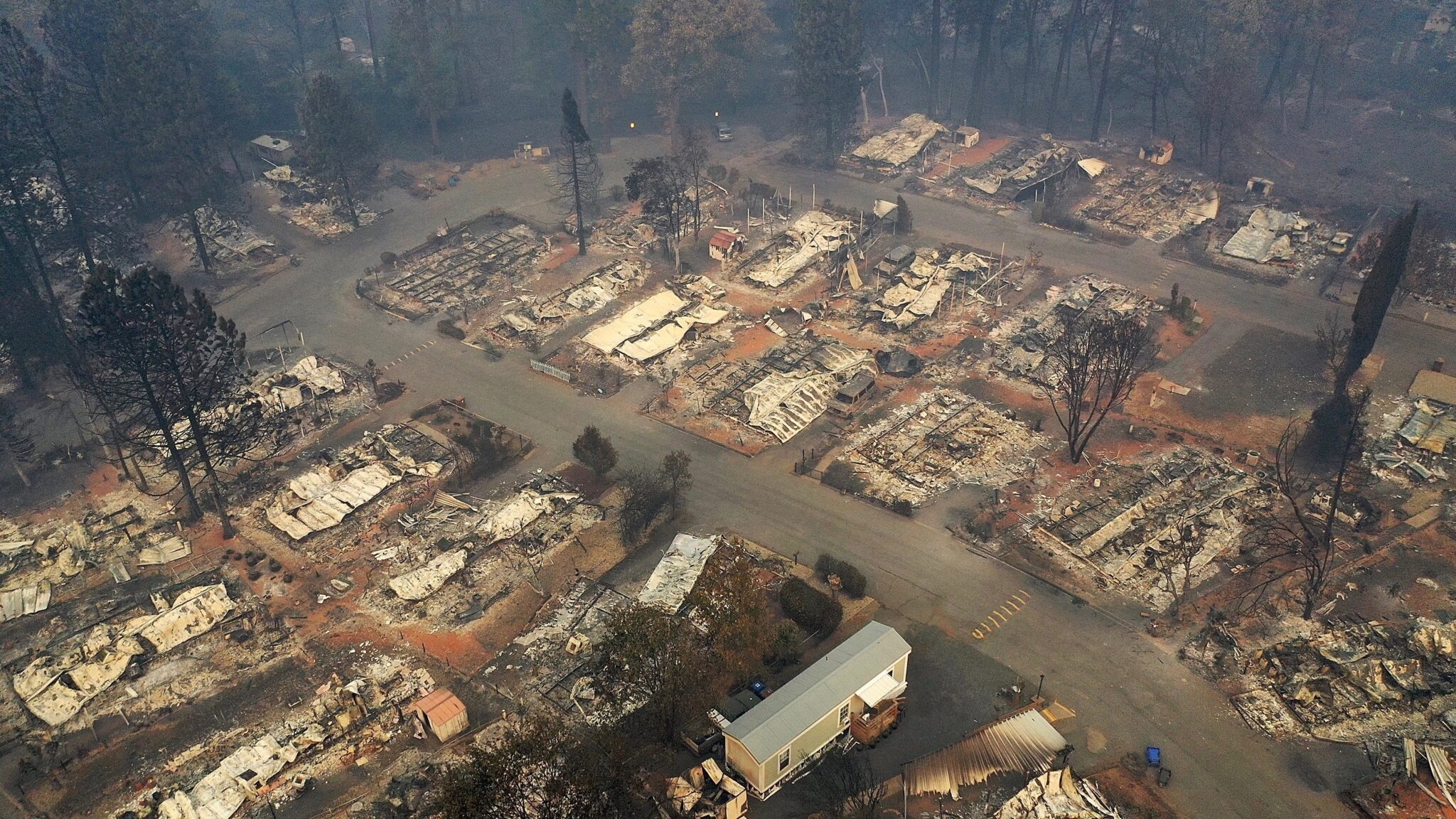

An aerial view of a neighborhood destroyed by the Camp Fire on Nov. 15, 2018 in Paradise, Calif. Justin Sullivan / Getty Images
Respecting scientists has never been a priority for the Trump Administration. Now, a new investigation from The Guardian revealed that Department of the Interior political appointees sought to play up carbon emissions from California’s wildfires while hiding emissions from fossil fuels as a way to encourage more logging in the national forests controlled by the Interior department.
The appointees looked to frame a story around the fires that would encourage a thinning of the forest through logging, which President Trump has said would help prevent forest fires. Experts have refuted his assertion.
The trove of emails that The Guardian uncovered show a coordinated effort to frame the carbon emissions from the 2018 wildfires as a blight that could be remedied by cutting down trees for logging.
The Trump administration has tried to make it appear that over-regulation, mismanagement, and forest protection are responsible for the severity of recent wildfires. However, a recent review published two weeks ago has concluded that the changing climate is the main culprit behind the sharp increase in wildfire risk.
“Overall, the 57 papers reviewed clearly show human-induced warming has already led to a global increase in the frequency and severity of fire weather, increasing the risks of wildfire,” said Matthew Jones, senior research associate at University of East Anglia’s Tyndall Centre and lead author of the review, in a statement. “This has been seen in many regions, including the western US and Canada, southern Europe, Scandinavia and Amazonia. Human-induced warming is also increasing fire risks in other regions, including Siberia and Australia.”
In the same statement, Professor Iain Colin Prentice, Chair of Biosphere and Climate Impacts and Director of the Leverhulme Centre for Wildfires, Environment and Society at the Imperial College London, added: “Wildfires can’t be prevented, and the risks are increasing because of climate change. This makes it urgent to consider ways of reducing the risks to people.”
The Trump administration decided not to follow that science and to use the wildfires as a way to promote industry. James Reilly, the director of the U.S. Geological Survey (USGS) who was once a geologist for the oil and gas industry, asked scientists to “gin up” emissions figures for him, according to The Guardian. Reilly also claimed the numbers would make a “decent sound bite,” and decided to discuss only the trees that produced outsized emissions to make “a good story.”
“Gin-up is an unfortunate phrase to be sure, but it might have been a very imprecise way to ask for an estimate. It certainly does not inspire confidence,” said Mark Harmon, a professor emeritus at Oregon State University’s College of Forestry, to The Guardian.
The Guardian presented the emails to scientists who concluded that Reilly either used misleading language or cherry-picked the data, or he intentionally exploited a disaster and manipulated the data for pro-industry purposes.
One expert told The Guardian that the numbers the interior department came up with are significant overestimates and that logging would not help prevent or lessen wildfires. In fact, logging could be deleterious as it negates the ability of forests to trap carbon dioxide from the atmosphere.
A USGS spokesperson, however, replied to The Guardian that Reilly’s emails were “intended to instruct the subject matter expert to do the calculations as quickly as possible based on the best available data at the time and provide results in clear understandable language that the Secretary could use to effectively communicate to a variety of audiences.” The secretary at the time of the emails was Ryan Zinke who had to resign under an ethics scandal.
Chad Hanson, an ecologist and co-founder of the John Muir Project, called the strategizing revealed in the emails a “blatant political manipulation of science,” as The Guardian reported.
- California Burns Because of the Climate Crisis While Trump ...
- Zinke Announces Plan to Fight Wildfires With More Logging ...
- NOAA Chief Violated Ethics and Scientific Integrity in 'Sharpiegate' Scandal - EcoWatch
- 'Sharpiegate': Commerce Department Blocks Release of Inspector General's Report - EcoWatch
- California, Washington and British Columbia Unite to Prevent Wildfires - EcoWatch
- 7 Devastating Photos of Wildfires in California, Oregon and Washington
- Latest Trump Rollback Allows Increased Logging in National Forests
- What Wildfire Smoke Plumes Reveal About Air Quality Over Time - EcoWatch

 233k
233k  41k
41k  Subscribe
Subscribe 